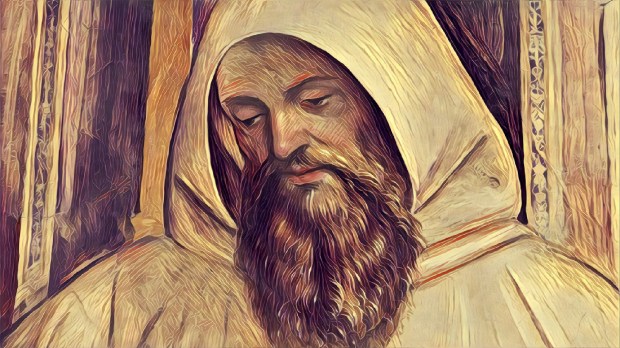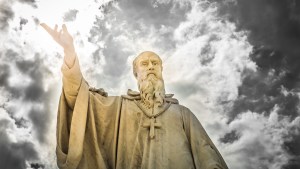Lenten Campaign 2025
This content is free of charge, as are all our articles.
Support us with a donation that is tax-deductible and enable us to continue to reach millions of readers.
The most well-known aspects of St. Benedict can be found on the St. Benedict medal: his many victories against sin and the devil, symbolized by the raven, the broken chalice, and the words of exorcism.
Here are some other facts about Benedict that are just as important, but which I have found are far less known.
First: St. Benedict died standing up.
March 21 was St. Benedict’s feast day for years, and still is in Benedictine abbeys, because it was the day he died in an unusual way.
He prophesied his own death, and ordered his tomb opened. Soon he was sick, and “on the sixth day of his illness, he had his disciples carry him into the chapel where he received the Body and Blood of our Lord to gain strength for his approaching end. Then, supporting his weakened body on the arms of his brethren, he stood with his hands raised to heaven and, as he prayed, breathed his last.”
Second: St. Benedict founded his order at age 20, and always trusted the young.
Benedict was 67 when he died in 547, and he is so often depicted as a wise old bearded man.
But as St. John Paul II points out, After “solitude and difficult trials, 1,500 years ago, when he was barely 20 years old, he founded the first Benedictine monastery at Subiaco.” He compared his emergence from the cave to a grain of wheat that planted itself in the ground, “becoming a fruitful ear of wheat.”
St. Benedict would later write in his Holy Rule, “All are to be called to council because it is often to a junior that the Lord reveals what is best” (Rue 3:3).
Third: St. Benedict attracted everyone from shepherds to scholars.
We think of monks as the wise scribes copying ancient manuscripts. But it is just as true to think of him speaking to the lowest classes in society.
After he himself rejected education, Benedict started out as a guide to shepherds. It was only later that he began to attract scholars and founded the great Monte Cassino monastery when he was nearly 50.
Dante describes Benedict in his account of heaven and explains that he attracted — and converted — rough characters. “That mount, upon whose slope Cassino lies, / was erst thronged on its summit by people / deceived and ill-disposed” and drew people “away from the impious cult which seduced the world.”
Fourth: He didn’t just preserve intellectual riches: He founded our system of commerce.
“St. Benedict is the saint who rebuilt society after the collapse of the Roman Empire,” accounting professor Dr. Lorenzo Patelli told me.
“It all started with St. Benedict. The whole idea of commerce-sharing social relationships, it all came from him.” Monks introduced new technologies, irrigation systems, crops, and bettered communities through business and established ways to account for it all. Later, “it was because of a friar that we have the credit and debit system.”
Fifth: St. Benedict was radically Christ-centered
Since he is known for the quaerere Deum, the quest for God, and his motto Ut in omnibus glorifiectur deum, That in all things God be glorified, St. Benedict’s spirituality can sound like it is more focused on spirituality in a generalized way.
Nothing could be further from the truth.
His rule instructs monks to nihil amori Christi praeponere, prefer nothing to the love of Christ (Rule 4: 21). In reaffirming him as a patron of Europe, St. John Paul II said Benedict’s Rule taught the way of the beatitudes and it was this that allowed Europe to flourish.
Sixth: St. Benedict was also radically centered on joy.
We think of St. Benedict as stern and ascetical, and that’s not wrong. But while many of us know the phrase Ora et labora, prayer and work,which is associated with St. Benedict, we don’t often hear the whole phrase, Ora et labora et noli contristari, Pray and work and be not sad!
In fact, St. Benedict’s Rule was meant to create a joyous atmosphere, first by establishing “good order” and specifically by curtailing “grumbling” and gossip.
For Benedict, even Lent was a joy. That was the reason he said each monk should give something up for Lent, “of his own free will, with joy of the Holy Spirit … and let him look forward to holy Easter with the joy of spiritual longing.”


